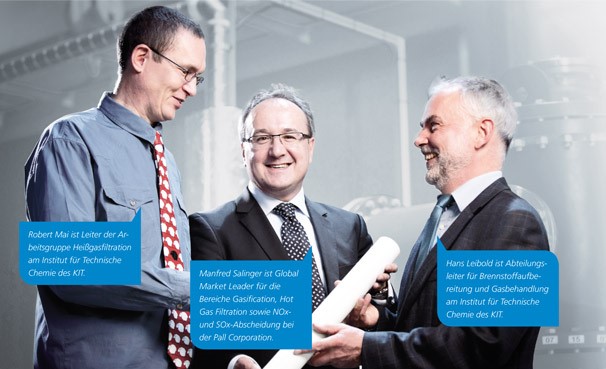The lignite is initially gasified. However, the synthesis gas produced contains micrometer-sized fine dust particles in addition to the desired gases. If they are not filtered out, they can destroy the turbine blades of the gas turbines in a very short time, which are used to generate the main part of the electricity - a loss of millions. KIT scientist Hans Leibold and his research group have been developing clever solutions for 'filter systems under extreme conditions' since the mid-1990s.
How does your filter technology get into the power plant?
Hans Leibold: "The power plant technology was developed by the US Utility Southern Company with support from the US Department of Energy DOE. Pall Corporation is supplying a hot gas filter system with 2,400 filter elements for the plant. The key technology for in-situ cleaning of these filter elements is based on a KIT invention, which was jointly developed to market maturity by KIT and Pall. Without KIT, these filter systems would probably not exist. They make the necessary long-term operation at high pressure and high temperatures possible in the first place."
What is the significance of the filters at Kemper County power plant?
Hans Leibold: "The advantage of our systems lies in an integrated maintenance and safety concept. First, they filter the dust particles from the hot synthesis gas and protect the turbine. Our innovative cleaning system ensures that the filters operate under constant operating conditions. Even in the event of a destroyed filter element, no dust can penetrate to the clean gas side. Our systems combine traditional high-temperature filter elements with an integrated safety system."
In the 1990s, the successful partnership between Leibold's working group and then filter company Schumacher, now Pall, began a seamless patent portfolio that was the basis for transferring the filter technology to industry from the very beginning. Today's KIT, then Karlsruhe Research Center, made a long-term investment in the further development of the technology towards the market. Manfred Salinger from PALL was a partner in the cooperation from the beginning.
Why was the cooperation interesting for PALL from the beginning?
Manfred Salinger: "The hot gas filter systems used in power plants have to be reliable and robust. If a filter system fails, this can result in a production interruption. Our motivation was therefore to raise the reliability and service life of the filter elements to an even higher level with the aid of a new cleaning system. In this respect, the cooperation with KIT was purposeful. Today, Pall produces and sells the best hot gas filter systems in the world."
The use of filter systems of this type results in a higher efficiency of the entire power plant and thus contributes to an improvement in the CO2 balance. KIT and PALL have walked the path from invention to market maturity together and are still working on new product ideas after this success. For example, for biomass gasification: The bioliq® plant at KIT's North Campus is currently testing how gaseous pollutants can also be efficiently filtered from synthesis gases at high temperatures and pressures.

